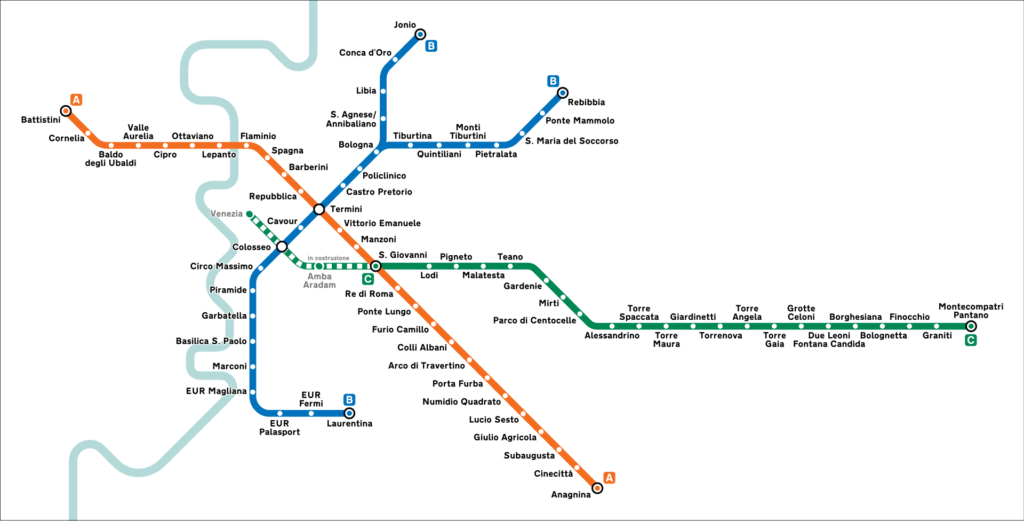Rome is a thriving metropolis with a robust and dependable public transit system. Buses, trams, metro lines, and light rail are the primary modes of public transit in Rome. The city and its environs are served by bus services. Rome’s primary tourist destinations are easily accessible through metro lines. While light rail connects the city’s center to the outskirts, trams cover places that buses and the metro do not. Rome’s public transportation system, ATAC, manages all forms of public transit, which are accessible via tickets or travel cards. The ATAC ticketing offices or approved merchants sell the tickets and cards, which are good for use on buses, trams, metro, and light rail services.
Metro system in Rome – Basic information
Rome’s metro system is a fantastic way to navigate the city. It is made up of three lines, Lines A, B, and C, all of which link the city’s core to its suburbs. Each day from 5:30 a.m. to 11:30 p.m., all three lines operate, and tickets are good for 75 minutes. Additionally, those with disabilities can access all three lines. Rome’s metro system is a fantastic method to travel about the city swiftly and easily.
The lines of the Rome subway system
Line A – orange (linea A)
Line A of the Rome Metro travels diagonally across the city, beginning at Battistini in the city’s northwest and ending at Anagnina in the city’s southeast. Line A meets Line B and Line C respectively at Termini and San Giovanni, where it continues on to San Giovanni. On Metro maps, the line is shown with an orange marking. It is estimated that Line A transports up to 500,000 people every day and is often very crowded throughout the day.
Line B – Blue (Linea B)
Rome, Italy is served by the Rome Metro, which includes the Line B line, which is one of the lines. Line B was really the first line that was constructed in the city, despite its designation. It travels across Rome in a diagonal direction, beginning at the Rebibbia and Jonio stations in the northeast and ending at the Laurentina station in the south, which is located in the EUR neighborhood. At the Termini station, it connects with Line A. On Metro maps, this line is represented in blue and it has a total of 26 stations.
Line C – Green (Linea C)
Line C of the Rome Metro runs from Monte Compatri-Pantano in the city’s eastern suburbs to San Giovanni, which is near to the city center, where it connects with Line A. Line A runs in the opposite direction from San Giovanni. It is the first metro line in the city to be fully automated and the third in total length. The route makes use of the ancient Rome-Pantano light railway, which is the last portion of the Rome-Fiuggi railway to be in pristine condition.
Map of Rome Metro 2023 – Free Download in PDF

Click and download the map of Rome’s underground system for 2023
A free PDF download that offers an up-to-date overview of the city’s public transportation system is The Map of Rome Metro 2023. All of the major subway lines and stations are included on the map, along with comprehensive details on costs, transfers, and service hours. For those who want to learn more about Rome and its many attractions, it is a priceless resource. An excellent planning tool for both local commuters and tourists, the map is simple to use and explore. The map is easy to download and is the best option for anyone looking for a thorough overview of Rome’s public transit system.
Public transport tickets in Rome – Best types for travelers & actual prices
The BIT ticket, which costs €1.50 for a single use and is good for 100 minutes on all buses, trams, and metro lines, is the initial kind of ticket. The ideal use for this ticket is for brief journeys or day visits into the city.
The CIS ticket, a multiple-use ticket that costs €7 and is good for one day of limitless travel on all buses, trams, and metro lines, is the next type of ticket. The greatest candidates for this ticket are those who intend to stay in the city for a few days because it may be used up to ten times.
The Roma Pass, a three-day pass that costs €36 and is good for unrestricted travel on all buses, trams, and metro lines, is the third type of ticket. Along with free admission to two museums, the Roma Pass offers discounts at a number of other attractions. For those who intend to stay in Rome for three days or longer, this ticket is the ideal choice.
Rome offers a variety of choices for buying tickets for public transportation. The best ticket for short journeys is the BIT, the best ticket for visitors who intend to remain in the city for a few days is the CIS, and the best ticket for visitors who intend to visit Rome for three days or more is the Roma Pass.
Timetables & Schedules of the Rome Metro System
Monday through Saturday, the Rome Metro system is open from 5:30 am to 11:30 pm, while on Sundays and holidays, it is open from 5:30 am to 10:30 pm. Three lines—Line A, Line B, and Line C—make up the metro system; they all pass through the heart of the city and cover the main sights. The metro operates every five minutes during rush hour and every 15 to 20 minutes during off-peak hours. On Friday and Saturday nights, the Metro also provides a night service that operates from 10:30 p.m. to 1:00 a.m. This limited-station night service runs every 30 minutes and covers only a few stations.
What Are Other Options For Public Transportation In Rome?
For those wishing to tour the city, Rome provides several public transportation choices in addition to the metro. These include the huge bus and tram networks throughout the city. In addition, railroads and trams connect the city’s center with outlying suburbs. The city also has a number of water bus routes that transport passengers throughout the city as well as to adjacent locations. Additionally, visitors can use Rome’s numerous bike-sharing programs to move around. All of these modes of transportation provide a practical and affordable way to see Rome.
how does the public bus transportation work in Rome
In Rome, Italy, public transit plays a significant role in daily life. Getting around the city by bus is a terrific way to see the Eternal City without having to deal with the traffic. Here’s how you get the most out of using Rome’s public buses.
Rome’s extensive bus network is used to transport people from A to B. All areas of the city, from the downtown to the outskirts, are connected by more than 700 bus lines that crisscross the area. Buses provide convenient transportation from early in the morning until late at night. The process of purchasing bus tickets is simple and easy. Tickets are available in newsstands, tobacconists, and convenience stores all across the city. All bus rides, including transfers to other lines, are 75 minutes long and are covered by ticket validity. You can also buy day passes for a full day of unlimited travel.
The 64, 75, and 81 bus routes are the busiest ones. From the Vatican City, the 64 travels through the heart of the city, and the 75 and 81 connect the train station with the Colosseum and the Forum, respectively. These bus routes are all excellent for sightseeing and provide breathtaking views of the city.
How do the public TRAINS work in Rome?
Roma Termini, Tiburtina, and Ostiense are the three primary train stations in Rome. The largest, busiest station in the world and the major hub for intercity and international trains is called Roma Termini. The second largest is Tiburtina, while the third is Ostiense. There are ticket offices, vending machines, and stores selling snacks, beverages, and mementos at each of the three stations.
You must buy a ticket in order to ride a public rail in Rome. The stations’ ticket offices, vending machines, and websites all sell tickets. Make sure to verify before you fly as prices vary depending on how far you are traveling and some tickets have time restrictions.
You can board the train as soon as you have your ticket in hand. In general, trains are cozy, hygienic, and secure. There is a conductor in each train car who will go through your ticket and respond to any queries you may have.
Rome’s train links to other Italian towns including Florence, Naples, Milan, and Venice are the most crucial. Tickets for these trains can be bought online or at the station, and they often run quickly and comfortably. Additionally, there are direct trains to other significant European cities as well as international trains to France, Switzerland, Austria, and Germany.
How To Get From Rome Fiumicino Leonardo da Vinci Airport (FCO) To The City Center With Public Transport?
The Fiumicino Leonardo da Vinci Airport, which is roughly 30 kilometers from the city center, serves as Rome’s primary airport. The Leonardo Express train is the quickest route to get from the airport to the city center. From the airport to Roma Termini Station in the heart of the city, this train departs every 30 minutes. The journey costs €14 and lasts roughly 30 minutes.
As an alternative, you can travel from the airport to Roma Termini Station on the Cotral bus. The trip to the city center on this bus, which departs from the airport every hour, takes around an hour. The ticket is two euros.
From the airport to Roma Termini Station, you can also take the Terravision shuttle bus. The trip to the city center on this shuttle, which operates every 30 minutes, takes roughly an hour. The ticket is six euros.
how to spend 3 days in Rome?
One of the oldest cities in the world, Rome is rich in culture, history, and natural beauty. Rome can be explored thoroughly in three days if you stay in the Eternal City. You’ll make the most of your stay in Rome if your itinerary is centered on one-of-a-kind experiences, fantastic restaurants recommended by locals, and fascinating nightlife.
Day One: A Tour of Historic Rome
Visit the Colosseum, one of Rome’s most famous landmarks, to begin your first day there. Spend the morning admiring the size of this historic Roman amphitheater and touring the nearby ruins. After there, proceed to the Pantheon, the world’s best-preserved pagan temple. Enjoy this 2,000-year-old structure’s stunning architecture before having lunch at the neighboring Piazza Navona. There are several charming restaurants and cafes lining this lively square.
After lunch, stroll through Rome’s charming streets and stop at some of the city’s most stunning churches, including the Basilica di Santa Maria Maggiore and San Giovanni in Laterano. Spend the evening with a meal at a neighborhood trattoria and a drink at a neighborhood wine bar.
Day Two: A Visit to the Vatican
A visit to the Vatican is a must on every trip to Rome. Explore the extensive Vatican Museums in the morning while marveling at the artwork and the splendor of St. Peter’s Basilica. Before going to the Castel Sant’Angelo for lunch, take a stroll in the serene Vatican gardens. This magnificent stronghold, which also houses a variety of eateries, provides breathtaking views of the city.
Explore the Spanish Steps and the nearby Piazza del Popolo in the late afternoon. After that, take a stroll through the old Jewish Ghetto before having dinner at a nearby Jewish restaurant to cap off the day.
Day Three: Enjoying the Nightlife
Spend the afternoon of your third day in Rome browsing the numerous shops and markets the city has to offer. Before going to the Trastevere district for dinner, do a little shopping at Campo de’ Fiori. Some of the city’s top restaurants, which serve delectable classic Roman food, are located in this busy region.
After supper, head to the Testaccio district for a night on the town. This neighborhood has a ton of intriguing bars and clubs, making it ideal for anyone seeking an entertaining nightlife experience.
What other metro systems are nearby to Rome?
Rome has a recognizable metro system, but there are others close by. There are many metro systems in Italy – Metropolitana di Milano, Metropolitana di Torino, Metropolitana di Napoli, Metropolitana di Catania.
Summary of our tour guide for Rome
I just had the chance to use Rome’s public transit, and I must tell it was an amazing experience. The city’s extensive and effective public transit system makes it the ideal method to travel about the area swiftly and conveniently. They were all dependable and comfy, whether I was riding a bus, tram, or metro. The drivers were courteous and supportive, giving me directions and suggestions throughout the way. Additionally, the price of the transportation was quite affordable, and purchasing tickets was an easy and uncomplicated process. Overall, I had a fantastic experience using Rome’s public transit system, and I heartily recommend it to anyone considering a trip there.
Top 5 FAQs and answers about Rome public transport?
What kinds of public transportation are offered in Rome?
- Rome has an underground metro system in addition to buses, trams, and other forms of public transportation. Additionally, there are a number of regional trains that connect to other Italian cities.
How can I travel around Rome the easiest?
- The metro is the best means of transportation in Rome. It covers the majority of the city and is quick and effective. Walking might be a convenient form of transportation if you are staying in a central location.
What is the cost of using Rome’s public transportation system?
- Depending on the type of ticket you buy, using Rome’s public transportation will cost you a certain amount. Single-use tickets are priced at €1.50. Additionally, there are discounted day, weekly, and monthly tickets available.
How can I purchase a Rome public transportation ticket?
- At each station, a ticket vending machine sells tickets for Rome’s public transportation. Alternatively, you can buy tickets at newsstands and cigarette shops.
Is Rome’s public transportation secure?
- Rome’s public transportation is typically safe, but it’s always a good idea to exercise caution by traveling with a friend, avoiding nighttime solo travel, and paying attention to your surroundings.
Useful links







